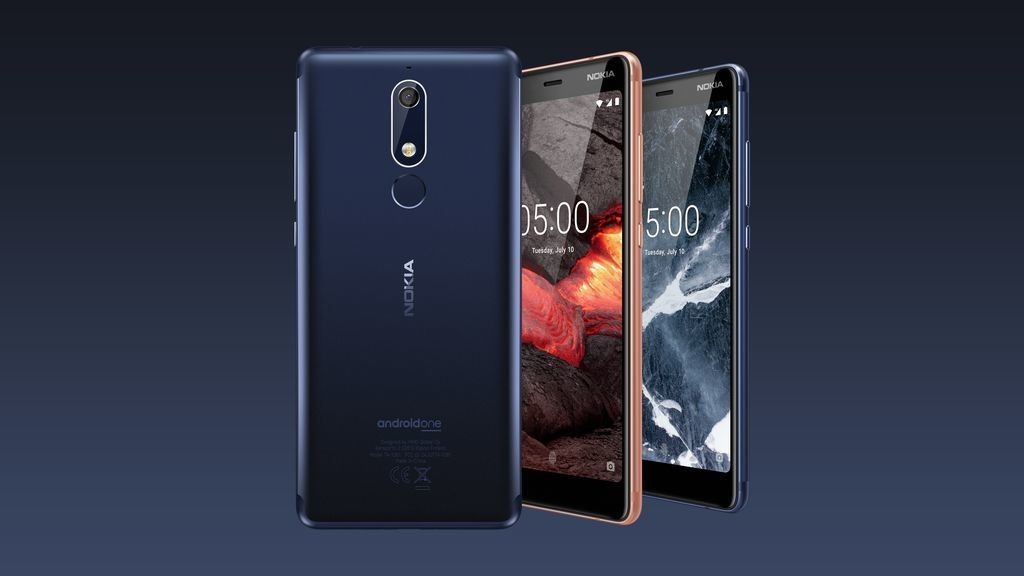
HMD Global officially announced the Nokia 2.1, Nokia 3.1, and the Nokia 5.1 in May. The phones are the successors to the Nokia 2, Nokia 3, and the Nokia 5 respectively. They slot in above the Nokia 1 Android Go entry-level phone and below the Nokia 6.1. The company’s smartphone lineup gets a bit more confusing with the entry of the Nokia X5 and the Nokia 6.1 Plus, both of which have significantly better specifications than their non-Plus variants.
In India, HMD Global launched the Nokia 6.1 back in April alongside the Nokia 7 Plus and the Nokia 8 Sirocco. Last month, the Nokia 3.1 arrived in the country. This week, the company launched the Nokia 2.1 and the Nokia 5.1 in India, and they are now available for purchase. Also, the 3GB RAM variant of the Nokia 3.1 is now available; previously, HMD Global had only launched the 2GB RAM variant. Full specifications of all three phones are noted below:
| Specifications | Nokia 2.1 | Nokia 3.1 | Nokia 5.1 | |
|---|---|---|---|---|
| Dimensions | 153.7 x 77.7 x 9.35mm | 146.25 x 68.65 x 8.7 mm, 138.3g | 151.1 x70.73 x 8.27 mm | |
| Software | Stock Android 8.1 Oreo (Android One) | Stock Android 8.1 Oreo (Android One) | Stock Android 8.1 Oreo (Android One) | |
| SoC | Octa-core Qualcomm Snapdragon 425 (4x Arm Cortex-A53 cores); Adreno 308 GPU | Octa-core MediaTek MT6750 (4x 1.5GHz Arm Cortex-A53 cores + 4x 1GHz Arm Cortex-A53 cores); Mali-T860MP2 GPU | Octa-core MediaTek MT6755S (8x 2.0GHz Arm Cortex-A53 cores); Mali-T860MP2 GPU | |
| RAM and storage | 1GB of RAM with 8GB of storage; microSD card slot | 2GB/3GB of RAM with 16GB of storage; microSD card slot | 3GB of RAM with 32GB of storage; microSD card slot | |
| Battery | 4,000mAh | 2,990mAh | 3,000mAh | |
| Display | 5.5-inch HD (1280×720) IPS LCD with 16:9 aspect ratio | 5.2-inch HD+ (1440×720) IPS LCD with 18:9 aspect ratio | 5.5-inch Full HD+ (2160×1080) IPS LCD with 18:9 aspect ratio | |
| Connectivity | Wi-Fi 802.11b/g/n, Bluetooth 5.0 | Wi-Fi 802.11b/g/n, Bluetooth 5.0 | Wi-Fi 802.11b/g/n, Bluetooth 5.0 | |
| Ports | microUSB port, dual nano SIM slots, 3.5mm headphone jack | microUSB port, dual nano SIM slots, 3.5mm headphone jack | microUSB port, dual nano SIM slots, 3.5mm headphone jack | |
| Bands | GSM: 900/1800MHz HSPA: 850/900/2100MHz FDD-LTE: Bands 1/3/5/ TDD-LTE: Bands 40/41 |
GSM: 900/1800MHz HSPA: 850/900/2100MHz FDD-LTE: Bands 1/3/5/ TDD-LTE: Bands 40/41 |
GSM: 900/1800MHz HSPA: 850/900/2100MHz FDD-LTE: Bands 1/3/5/ TDD-LTE: Bands 40/41 |
|
| Rear camera | 8MP with LED flash | 13MP with f/2.0 aperture, LED flash | 16MP with phase detection autofocus (PDAF), LED flash | |
| Front-facing camera | 5MP | 8MP with f/2.0 aperture, 84-degree field-of-view | 8MP |
Pricing and availability
The Nokia 2.1 costs ₹6,999 ($101) in India, and comes in three colors: Blue/Copper, Blue/Silver, and Grey/Silver. The Nokia 3.1’s 3GB RAM/32GB storage variant is now available for ₹11,999 ($173), and color options are Blue/Copper, Black/Chrome, and White/Iron. (The 2GB RAM variant of the phone was launched last month for ₹10,990).
Finally, the Nokia 5.1 comes in three colors: Copper, Tempered Blue, and Black (the Black variant will be available after a few weeks). It costs ₹14,499 ($209) in India. All three Nokia smartphones are now available for purchase via major mobile retailers and online via Nokia’s online store and Paytm Mall.
Launch offers include 10% cashback on Paytm recharges and bill payments when scanning the Paytm Mall QR code at a retail store, and 5% cashback for ICICI debit and credit cards (only for Nokia 3.1 and Nokia 5.1). Bundled data offers are also being offered via Vodafone and Idea.
Our view: In terms of the competition, it’s fairly clear that HMD Global’s newest budget phones don’t perform well when it comes to the price/performance ratio. In the budget and lower mid-range segment, companies like Xiaomi, Asus, Realme, and Honor are providing much better phones at lower prices. It would not a be an overstatement to say that the Nokia 2.1, Nokia 3.1, and the Nokia 5.1 are all overpriced phones as they fail to be on par with phones such as the Asus ZenFone Max Pro M1 and the Realme 1 in terms of specifications.
The phones do have a few plus points including being powered by Android One, but even that’s not a big differentiating factor anymore as the Asus ZenFone Max Pro M1 is also powered by nearly stock Android. In our view, HMD Global should revise its pricing policy if it wants to seriously compete with the likes of Xiaomi, Asus, and Honor.
Via: Gadgets 360
Want more posts like this delivered to your inbox? Enter your email to be subscribed to our newsletter.

No comments: